All told, I spent about one-and-a-half months last year in Palau, comprising three visits to photograph the bumphead parrotfish spawning aggregation, with time between dives spent looking for additional opportunities to capture unique images.
The amazing spectacle of so many bumpheads in a frenzy of synchronized spawning whet my appetite for fish sex voyeurism, so one area I invested considerable time researching was the possibility of documenting other awesome oceanic orgies.
To succeed at just about anything, it's vital to stay focused, so I eventually homed in on a single species from several possible candidates: Lutjanus bohar, commonly known as two-spot or twinspot red snapper.
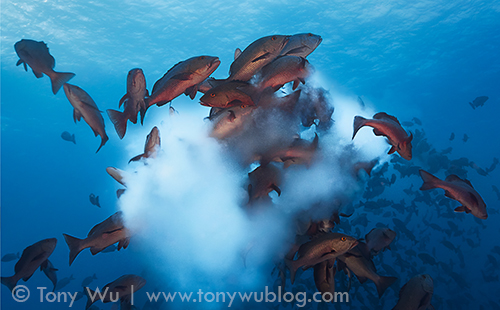
Twinspot snapper (Lutjanus bohar) releasing cloud of sperm and eggs
They are relatively common fish in the tropics, often hanging out at corners and off reef edges, coming in to eyeball divers from time to time. If you've been diving for any reasonable length of time, I'm sure you've seen them, though probably solitary ones or just a few at a time. You may also have noticed that they have nice sharp teeth, which is a clue to how they make their living. More on that topic later.
My reasons for homing in on this species were many, but among the most important considerations was the fact that Clayton, my intrepid dive guide at Blue Marlin, had a bit of previous experience diving with these fish while they were spawning. Not a lot, but enough to be able to relate some details and pique my interest.
In a nutshell, the existence of the L. bohar aggregation in Palau has been known for some time, so I have no doubt that recreational divers have seen this phenomenon before. In fact, there are two known red snapper spawning aggregations in the archipelago, one accessible from Koror (the one I photographed), and another at Peleliu, which is south of Koror.
Given this...one thing that puzzled me as I gradually gleaned information about spawning of this species was why there weren't many photos. Checking with search engines turned up only a handful of images; nothing particularly impressive at that, and not really showing actual spawning. It's certainly possible such photos exist, but if they do, they're not easy to find.
The best images I've seen of large aggregations of Lutjanus bohar are from the Red Sea, where they gather in June/ July each year. As far as I know, no one has documented actual snapper spawning there, though from viewing photos my friend Julian has taken from that area during trips with Alex Mustard, I'd wager that the fish congregate to spawn in large groups there as well.
Anyway, with the apparent lack of precedent, I was excited, but simultaneously concerned about the prospect of being skunked.
I mean...lots of divers over many years in a very popular dive destination + documented phenomenon = no decent photos? That's sort of like someone telling me that 2 + 2 = 9. Something seemed fishy (sorry, couldn't resist).
So over the course of my visits to Palau, Clayton and I discussed the fish, the habitat, the likely scenarios, the potential pitfalls, my many questions, and my never-ending list of concerns. Basically, I was nervous about committing time and air bubbles to a project that seemed like it might have a high chance of flopping. Poor guy probably dreaded our surface-interval chats!
Trooper that he is though, Clayton took the initiative to do a few trial dives while I was gallivanting around other remote corners of the planet. What he observed and learned set the groundwork for success.
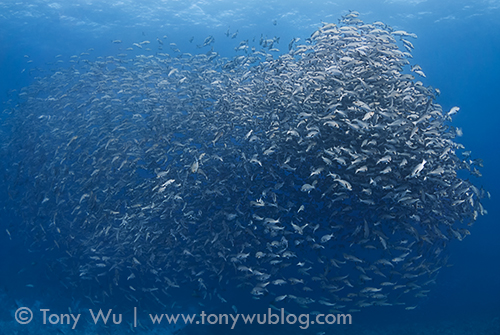
Thousands of Lutjanus bohar snappers performing an impression of a Möbius strip
It's D*mn Hard
After much deliberation, I decided to cleave to my time-tested philosophy of Act First, Think Later, so after my humpback whale season wrapped up and I cranked out my humpback whale calf count for 2012, I travelled back to Palau to give the snappers a go.
Remember how I said it's an advantage to be in good shape for the bumphead party? Well...ditto that several times over for snappers.
As soon as I hit the water the first time, one likely reason I couldn't find great photos of Lutjanus bohar spawning became immediately obvious. Keeping up with them is d*mn hard!
The action takes place at a dive site called Shark City, which is about 37km (23 miles) from Koror. For you diving history buffs, this site was at one point Palau's signature site for diving with sharks, hence the name, but the discovery and subsequent popularity of Blue Corner changed that. Of course, divers still visit Shark City, but not as often as back in the day when there were fewer options.
Geographically, the actual reef formation is a point that is the westernmost part of Palau...meaning that it's exposed to open ocean. As a consequence, the current can be quite strong, which, I'm willing to bet, is part of the reason the snappers have chosen this area for group spawning.
When fish like snappers spawn en masse, they inundate the ocean with gametes (sperm and eggs), with the objective of overwhelming other ocean residents that come in to hoover up the instant meal (just add water!).
The fertilised eggs that escape predation get sucked out to open water by the current, where the zygotes (little fishies to-be) have a chance to grow, with some percentage surviving to become snapper juniors, and a few eventually returning to reefs to take up residence (same basic storyline for the baby bumpheads BTW).
Clayton's diligence and advance intel prepared me somewhat for the strong current, but it was still tough going. The flow of water over the reef was steady and unrelenting. And even though there were several thousand(!) fish, all of which were potential photographic subjects...my first foray turned out to be a frustrating one. I flubbed it.
Bohar vs. Boxfish. So Not a Fair Fight.
Twinspot snappers are carnivorous piscivores, a fancy way of saying that they prey on other fish.
For voracious hunters, they're teeth aren't actually all that big if you see them up close, but they are certainly sharp and effective...as I had a chance to see for myself.
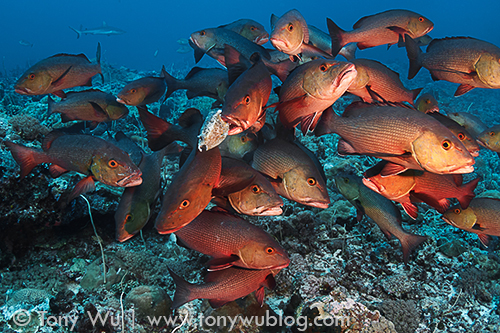
A swarm of two-spot red snappers that devoured a boxfish
During one of my dives, I swam over to check out a bit of activity on the reef.
What initially appeared to be two or three socialising snappers transformed into a sudden whirlwind of activity. In much less than the blink of an eye, the area around a small coral formation became a chaotic tempest of fish gone mental, kicking up bits of substrate and clouding up the water.
Like sharks in a feeding frenzy, the snappers had cornered something!
One of them must have drawn blood, triggering the bout of crazed predation I was witness to. Fish parts flew in all directions, as seething snappers tore their unfortunate victim to shreds.
Everything happened so quickly that I wasn't able to get a look at the victim while it was whole. When all was said and done, the only thing remaining was the hard carapace of a boxfish, which one of the snappers kindly deposited at my fins, as if to answer my silent question, "What was that?"
Since I didn't see the fish while it was alive, I can't be 100% certain what kind of boxfish it was, but judging from the bright yellow/ orange patterns, I'm guessing that it was a yellow boxfish (Ostracion cubicus). Adults of this species become somewhat bluish in hue with yellow seams between the plates comprising the body. If you happen to be super clued-in on boxfish leftovers and have a better idea of what it might have been, please let me know.
I have no idea what happened to spark the gang attack, but as soon as there were no more tasty morsels left, the snappers calmed right down and rejoined thousands of their kin schooling nearby.
Within seconds, the reef and fish were back to normal, as tranquil and still as if nothing had transpired.
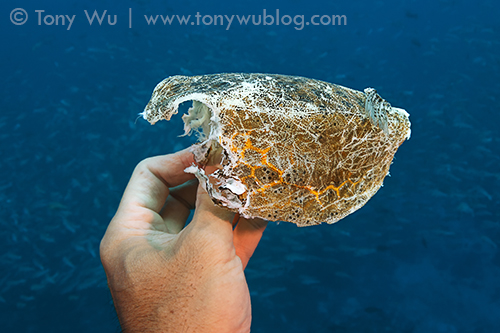
Boxfish leftovers, with swarm of Lujanus bohar snappers in background
If at first you don't succeed, try, try again.
The night after my flubbed attempt, I had a nice long chat with myself (yes, I do this more than it's perhaps wise to admit), replaying the events of the morning time and again, trying to work out what went wrong. It went something like this:
"You idiot. There are thousands of fish. How can you not get a decent photo?"
"But the current was strong. The light was low. The visibility wasn't so great either. And they moved a lot!"
"Again. You idiot."
To which I had no reasonable response, other than to whinge more, which isn't terribly gratifying when there's no one around to listen.
Anyway, I eventually worked out several things to bear in mind for my next attempt: the fish clump together a lot more than the bumpheads (which tend to be all over the place in a perfect illustration of Brownian motion); spawning seems to run like a chain reaction up and down the mass of fish; and it seemed that, with a bit of careful observation upon initial entry, it might be possible to anticipate where the fish would go, rather than try to keep up with them. "Skate to the where the puck's going, not where it's been," as Wayne Gretzy advised.
So early the next day, I went out once again with Clayton, and I hit pay dirt.
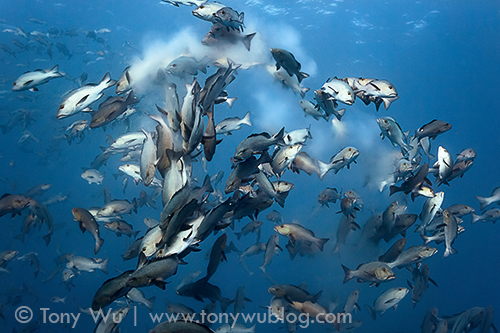
Twinspot Snapper (Lutjanus bohar) spawning rush
Getting into the right place at the right time was still a challenge, but my intrapersonal banter wasn't for naught. With the experience from the day before, my timing was better. I was able to conserve air and energy until just the right time, then position myself so that the action came to me.
I love it when a plan comes together.
Having better luck also allowed me to observe large numbers of the fish at close range. I noticed something interesting.
Lutjanus bohar are commonly referred to as "red" snappers. Every time I've seen them while diving on reefs, they've been red, so the name made perfect sense to me.
As it turns out though, while the fish are engaged in their mating manoeuvres, they adopt a wide range of colourations and patterns, ranging from nearly white to striped with various shades of red, yellow, brown (i.e., warm tones).
The fish seem able to switch colouration rapidly, and they also seem capable of turning their white spots on and off...so that some individuals at any given time exhibit white spots on their backs while others don't.
It's certainly not unusual for fish to change hues and/ or patterns for mating, so while I was amazed to see the colour shifts, I wasn't terribly surprised.
I'm not sure if anyone has documented these colour changes among bohar snappers before though, so again...if you have any insight, please let me know.
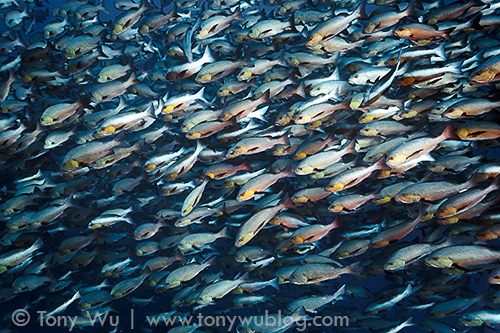
Red snappers displaying a range of spawning patterns and colours
Predators
Another thing worth mentioning is the predators that cruise in to take advantage of spawning aggregations.
In the midst of the bumphead spawning, I saw grey reef sharks and bull sharks a few times, which were presumably attracted by the commotion caused by so many frantic fish. I'm not sure if sharks are able to take any bumpheads during mass spawning, but it would certainly be an amazing spectacle to see a large bull charge in and snatch a bumphead mid-spawn.
With the two-spot red snappers, there were hundreds of midnight snappers (Macolor macularis) attacking every cloud of fish jizz possible in order to gulp down snapper sperm and eggs...sort of yicky, but I guess a fish has to do what a fish has to do.
Far from being scary, the midnight snappers just looked...dorky. They got in the way of photos, as their darkness sucks in all light (both available and artificial), producing unsightly underlit splotches. They were more of a visual annoyance than anything else.
But...there were sharks too.
Because the snappers tend to stick together more than bumpheads while spawning, their clouds of sperm and eggs tend to be thicker and more concentrated. Quite a few times, a rampaging shark appeared suddenly out of the white haze, sort of like a speeding car without headlights materializing without warning in the fog.
Again, I didn't see any of the sharks actually grab a fish, but given the abundance, concentration and relatively small size of snappers, I'm guessing that sharks probably treat snapper spawning aggregations like the fresh fish table at a Sunday buffet.
Most of the time, encounters with sharks were too quick and unpredictable to fire off my camera, but I did manage to get a photo of one shark just as it turned:
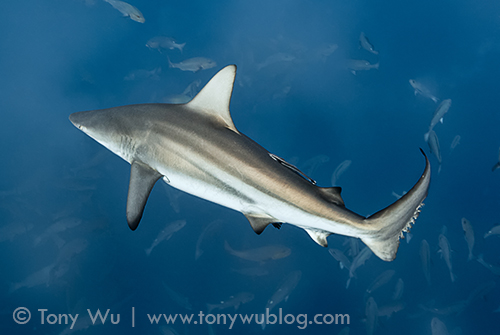
Blacktip shark (Carcharhinus limbatus) swimming through spawning snappers
It's a blacktip shark. Not the species you find around reefs (Carcharhinus melanopterus), but Carcharhinus limbatus, a fish that lives in coastal waters, and that...as far as I know...I've never seen before.
Note the pronounced striped pattern on the shark's flank, as well as the black tips and edges of the animal's fins.
The raggedy trailing edge of the caudal fin is interesting too. This doesn't seem to be mentioned in online descriptions of this species, but several people I consulted in Palau mentioned this feature, so perhaps it's a trait that's characteristic of the local population. Or maybe it's just coincidence.
Either way...that's cool, eh? (I'm practicing my Canadian-speak for an upcoming trip to the Great White North.)
One More Post
I have one more post I want to write to round out my summary of photographing spawning aggregations in Palau last year.
In reflecting upon my experiences and doing a post mortem of sorts, there are a number of themes and lessons I feel compelled to highlight, both about diving/ photography in general, and also with specific reference to the spawning aggregations. Delving into that stuff in this post would make it way too long!
I'd also like to set out an overview of planning considerations pertaining to diving with the spawning spectacles, a description of what it's like to dive with Blue Marlin, and how to get in touch with the dive shop if you're keen to give this a go.
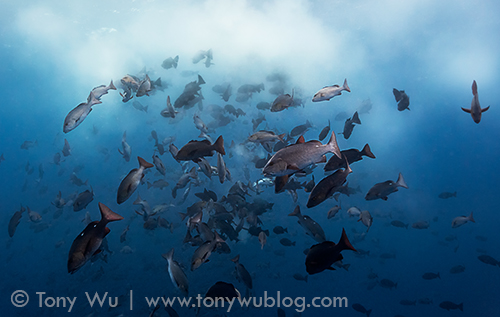
Early morning group sex, two-spot snapper style
Related Posts:
Part 1: Bumphead Parrotfish Spawning Aggregation in Palau
Part 3: Diving with Spawning Aggregations in Palau